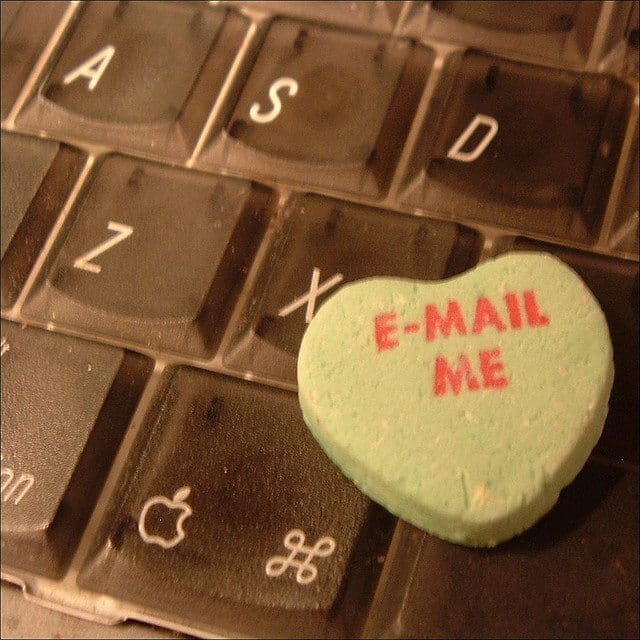 Only 25% of your leads are sales-ready. In addition, a whopping 50% of your leads are qualified but not ready to buy from you. [Gleanster Research]
Only 25% of your leads are sales-ready. In addition, a whopping 50% of your leads are qualified but not ready to buy from you. [Gleanster Research]
So as an email marketing pro, what do you do with those qualified but reticent leads to turn them into customers? Lead nurturing, of course! In fact, HubSpot’s research indicates that lead nurturing emails generate an 8% click-through rate, compared to regular email marketing that generates only a 3% click-through rate.
Those numbers make lead nurturing sound pretty good. . . and it is! Here are 6 types of emails you can add into your lead nurturing mix to keep you leads moving through the sales funnel.
1. Email that educate
Most lead nurturing emails help to educate your prospects. Address their challenges and teach them about the things they want to know. Use your buyer personas and on-site and off-site behaviors to be sure you’re providing the right kinds of information.
What did they download already? What pages on your website do they visit most often? What are they tweeting about? What are their pain points?
Focus on only one topic per email, and educate them over time as they move through the sales cycle. Don’t be “salesy” in these emails, but be sure the information you’re providing corresponds to your service and product offerings.
2. Email that interests them in your next offer
Your prospects have converted on something — now give them a chance to reconvert on your next offer. For example, if you converted on our 2015 HubSpot User’s Guide to Email Marketing Analytics, you might also be interested in our Buyer Persona Toolkit. This next offer should be something that encourages your prospects to move down the sales funnel.
3. Email that help them improve their results
Everyone’s looking for something that will make them better at their job — send lead nurturing emails around improving ROI, or making their work life more organized, or about a new tool or process you use that they would be interested in using, too. Positioning yourself as someone who can make their lives better makes you their ally and helps establish the trust you need to turn them into a customer.
4. Email that broadens your connections with them
The more ways through which you and your prospect are connected, the better chance you have of closing the sale. Send lead nurturing emails that invite them to subscribe to your blog, connect on LinkedIn, follow each other on Twitter, and any other places you both live in the web. The more interconnected you are, the more you become a part of your prospect’s daily life and increase the opportunities to impress them with your content, solutions, and brand.
5. Emails that re-engage them
If prospects have fallen off the map — either they click through your emails less frequently, or they aren’t responding to your sales team as much — send them something to re-engage them with your company.
People love giving feedback, so ask your subscribers for feedback on things like email frequency, content quality, and subject matter to see if there’s something you can alter to better suit their needs. Best case scenario: you get the knowledge you need to better customize your prospect’s emails. Worst case scenario: your prospect either doesn’t respond or opts out of your emails, acting as a list scrubbing mechanism that only helps your email marketing efforts by weeding out leads who wouldn’t have been a good fit for your products/services anyway.
6. Emails that are personal
personalized email is good — personal email is even Not all lead nurturing emails have to be automated; think outside of the lead nurturing track and consider when an email from you, a member of your sales team, your founder, or even an engineer or support rep, might help you close your sale. This is particularly helpful near the end of the sales cycle to help address any of the issues that have been plaguing the prospect.
For example, is your prospect excited about your service but fixated on an administrative aspect of the purchase such as billing cycles? Have your in-house accountant email your prospect and offer an opportunity to chat. Or perhaps some technical aspects of your product are still worrisome. Have your product engineer reach out with an email that will help address any final objections. Personal touches like this can help push a prospect through the last stages of the sales cycle and make your company stand out as one that goes above and beyond for their customers.
Takeaways
There are lots of different kinds of lead nurturing emails that you should be sending. Perhaps a personal email that invites them to a private webinar, or an invitation-only event. Or re-engage them with a survey on a topic of interest them, and promise that you’ll send them the survey results. Be creative and have some fun with your lead nurturing. It don’t have to be formulaic, but it does need to connect with your audience at the point that they are at in your sales cycle, and it should provide useful information or opportunities.
Then be sure to track you results in your email analytics. Discover the places that your lead nurturing process falters, and change it up. We find that a healthy curiosity about analytics is really helpful. To satisfy your curiosity, check back on your email analytics frequently and make adjustments as needed.





